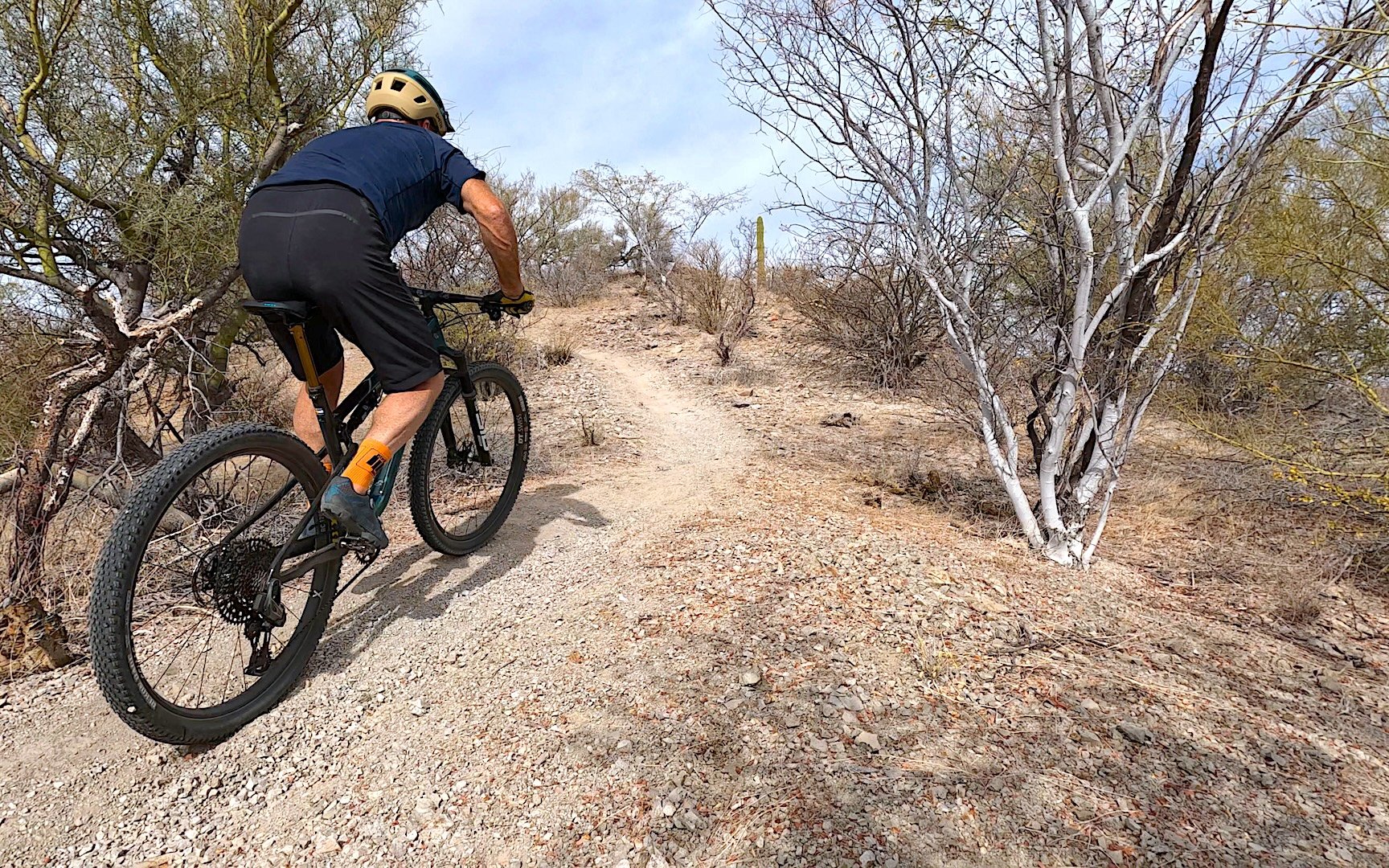
First Impressions
The Yeti ASR - (Fast) New Dog, Old Tricks
Yeti’s Latest Flex
Yeti have just released a new XC bike. For people new to the sport of mountain biking, that may seem out of character for the Colorado-based brand, since the overarching ethos for the past seven or eight years has been all about Switch Infinity suspension and buttery smooth trail bikes. But Yeti has been around a while. The first ever Yeti was called simply “F.R.O” – For Racing Only. Russel Worley was a terror on the SoCal XC scene aboard his aquamarine F.R.O, and Jimmy Deaton flat out owned the Mammoth Kamikaze with his Yeti. Not long after that, some guy named John Tomac created a stir aboard his drop bar Yeti C26 at the Durango World Championships in 1990, and his teammate at the time, Juli Furtado, put her Yeti in the rainbow stripes. XC racing was part of the brand DNA.
This new XC bike, the ASR, is a looooong way evolved from those storied years gone by, however. Like just about every other dedicated XC race weapon these days, the ASR features a carbon fiber frame, with a linkage driven single pivot suspension and a one-piece rear triangle that flexes ever so slightly in order to let the suspension do what it needs to do without resorting to another pivot somewhere near the rear axle. This is THE formula for full suspension XC race bikes now, as evidenced by last week’s debut of Specialized’s new Epic and Epic EVO models. These bikes join Cannondale, Cervelo, Kona, Santa Cruz, Scott, Transition, Trek and whoever else I am leaving out in bringing to market a bike that is aimed explicitly at the needs of XC racers, and achieves that desire for both speed and functional full suspension with as little carbon fiber and as few pivots as possible.
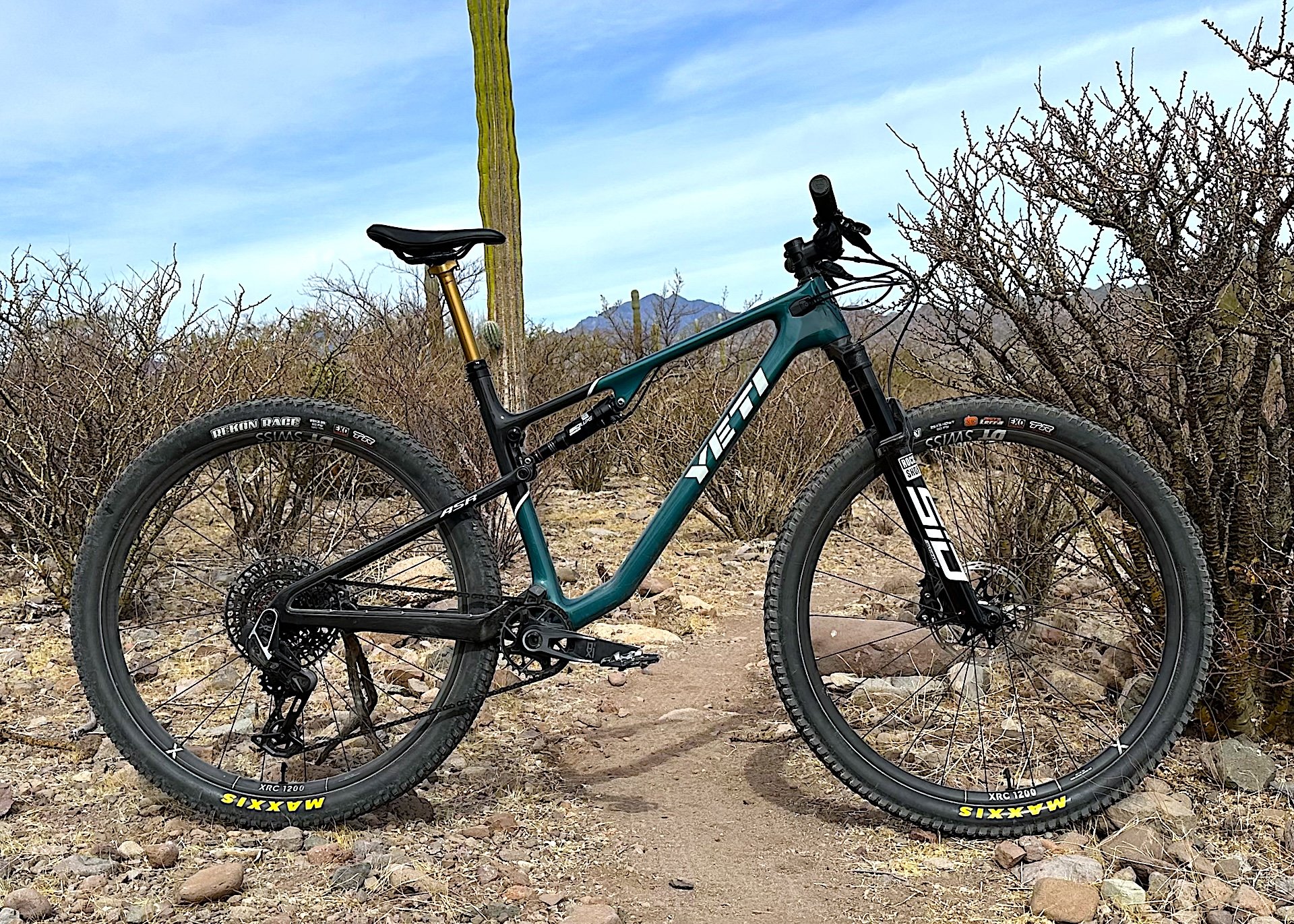
Surrounded by sharp things that make people bleed, the new ASR is right at home...
One might think that the ASR is late to the party, what with the Epic dropping a week ago. One might also think this is a bit of an about face for Yeti, who have been fully invested in their Switch Infinity suspension design for the past seven years. One might wonder, if one has a short memory, just what kind of experience Yeti has in this milieu. That’s the funny thing with memory. We forget stuff real fast. Whatever. This is not exactly unfamiliar territory for everyone’s favorite abominable snowman. In fact, it could be argued that Yeti have more experience with this particular manner of building a bike than anyone. Let’s take a quick stroll through the archives to recap. Pictures being worth 1000s of words and all:

Before the flex... the original ASR.

See that teeny tiny little flex plate on the seat stay there, just above the derailleur? It begins... 2004.

Seat stays morph to carbon fiber. 2007.
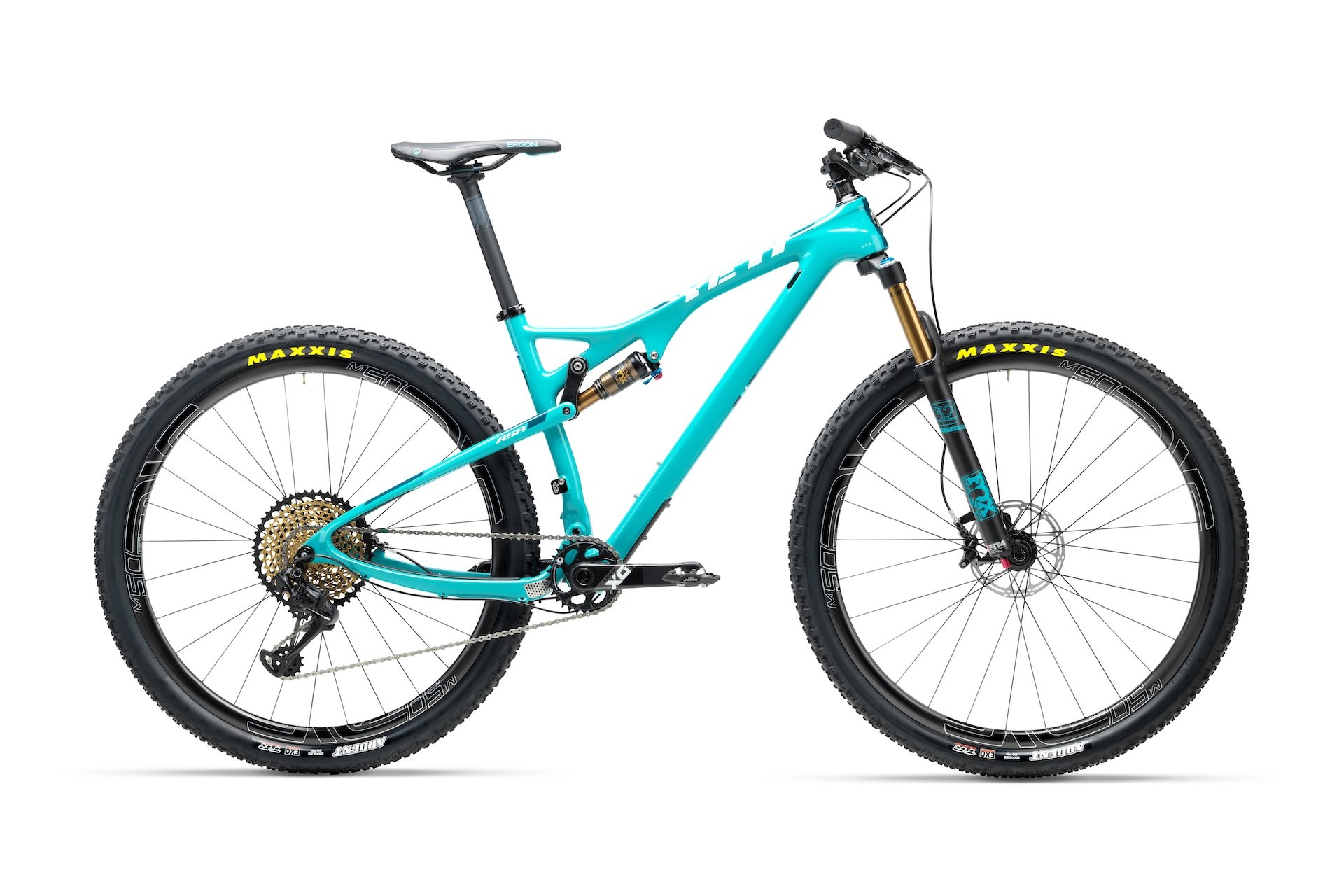
The thoroughly modern ASR era began in 2015, and ended here in 2017.
Okay, glad we got that sorted. Yeti know their way around flex-stay design. But now, we get to ask why they are backtracking into this already familiar methodology after ditching it for Switch Infinity in 2017. One Word: WEIGHT.
Switch infinity is an incredible suspension design. It does a very good job of providing plush responsiveness off the top without any pedal induced kickback or traction issues, doesn’t bob under power, has a beautiful linearity through the mid stroke and generally ramps up very nicely toward bottom out. Smooth, predictable, capable across a huge range of terrain, it is a very refined suspension design. It is also complex, and complex in a way that makes it difficult to carve weight out of a frame and make an XC racer happy.
When it comes down to foaming at the mouth and elbow checking Nino Schurter into the first corner, nobody cares about plush off the top tractability. They care about weight. Or, more specifically, the absence of it. So when it came time to make Geoff Kabush and Jared Graves happy (Man, it feels so weird to refer to Grubby as an XC racer, but here we are and there he is, and damn it’s good to know he is still ripping off legs and making people scared), along with whoever else Yeti may be slyly lining up for a run at some podium glory, the ol’ dickinabox had to go.
What we have here is a 115mm travel rocketship with geometry that falls squarely into the “new school” XC paradigm – 120mm fork travel, 66.5 degree head angle, 75.5 degree effective seat angle, 460mm reach on a size large, and a combined frame and rear shock weight of 1813 grams. For those counting in Freedom Units, that’s a sub-4lb frame and shock weight. 30% sag, flex zone in the seat stay, twist grip lockout on the handlebar activating both front and rear dampers, on your marks, get set, go.
That’s not to say this is a simple bike, however. The ASR is not some dumbing down of core values to appease a market segment. Reductive design principles, yes. But simple, ehhh, don’t go jumping to conclusions just yet. The ASR represents the application of laminate technology taken to obsessive lengths in pursuit of flat-out XC speed, an uncompromising execution taken to such extremes that compromises have been made in sacrifice to that uncompromising goal. Sound confusing? Excellent. Stick with me here and I will try to make sense of it.

DETAILS
Yeti employs what they are referring to as a Zero Redundant Carbon layup process – essentially cutting each ply of carbon in each area of the frame into more precise, more complex shapes, and being hyper critical with placement. This allows them to reduce any excess ply overlap, smooths transitions between each ply, and thus reduces weight while still maintaining desired strength and ride characteristics. They went through 36 layup iterations before arriving at the final map. Each size frame gets its own specific layup, and each size is tuned to deliver the same ride feel across the size range – so that the torsional stiffness of a small frame with a small rider will ideally be recognizably similar to the torsional stiffness of an XL frame with a Clydesdale at the bars. Continuing the theme of design proportioning and rider center consideration, each size frame gets its own chainstay length.
There are the now expected “C” and “T” frame variations, as well as a “T-Series Ultimate” frame which is designed to be run with no cables aside from the rear brake hose. The least expensive “C” frames feature full internal cable routing, with tube-in-tube guides. The “T” frame does away with the tube-in-tube guides to save weight, the upper link goes from 6000 series aluminum to a forged 7075 unit, also in the name of weight savings, and the T-Series Ultimate frames do not even have ports in the frame or swingarm for derailleur or dropper cables. Titanium shock bolts, shaved rear axle, 2 water bottle mounts, UDH, and threaded bottom bracket are standard across all frames. T-series frame weight is 1,552 grams, and the T-Ultimate clocks the scale at a very svelte 1,448 grams. T-series frame with a SID Luxe Ultimate shock weighs 1,813 grams, and a C-series with a SID Luxe comes in at 1,985 grams. So we can assume that the added silence of internal cable guides and the lower budget layup comes at a cost of about 170 grams. A complete T3 or T4 build (see the attached images for exact spec) should weigh around 22.5lbs. In an ironic black eye to the coming Singularity, the T5 wireless build, with the lightest frame of the bunch, hits the scale at 22.9lbs thanks to the added heft of the necessary Flight Attendant componentry. For the full breakdown of weights and measures, see below.

There is a full complement of rubberized protective bits – textured chain and seat stay pieces, downtube protection, swingarm flap in order to prevent muck or rocks getting wedged behind the swingarm pivot, and a built in chain guide. On the T-Ultimate, none of those pieces are actually installed except for the chain guide, since people who weigh their food and contemplate surgical rib removal are also the kind of people who will go to extreme lengths to reduce weight. I’m kind of surprised there’s a head badge, come to think of it. The chain guide, by the way, is sized to work with any chain ring between between 28 and 38 teeth, with the caveat that you can only run a 38t ring on the medium and larger size frames, and that no self-respecting XC racer, not even a Nepalese junior, would ever be caught dead running a 28t ring.
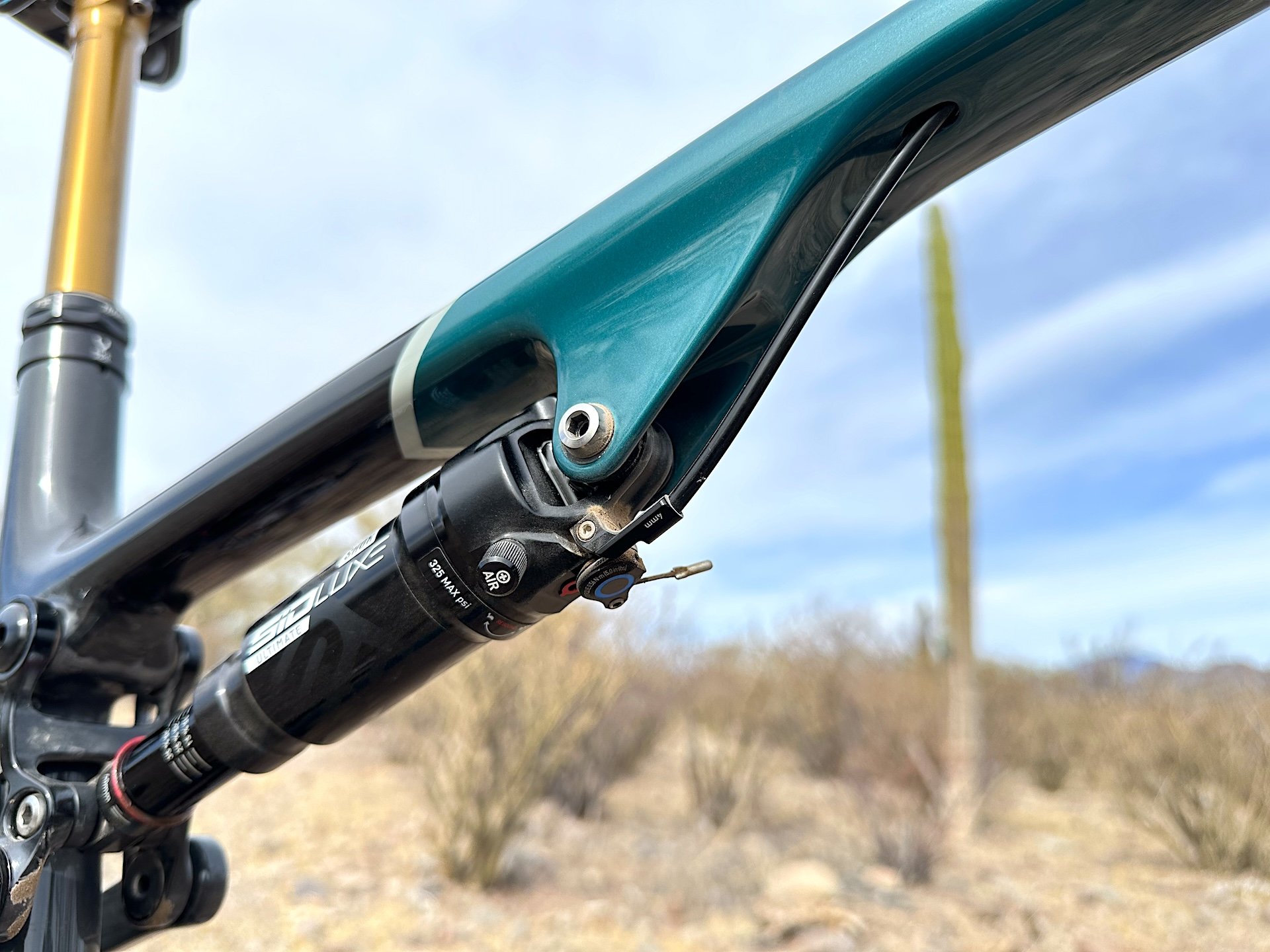
Remote lockout, internal remote lockout routing, ti hardware, all or nuthin' dropper...
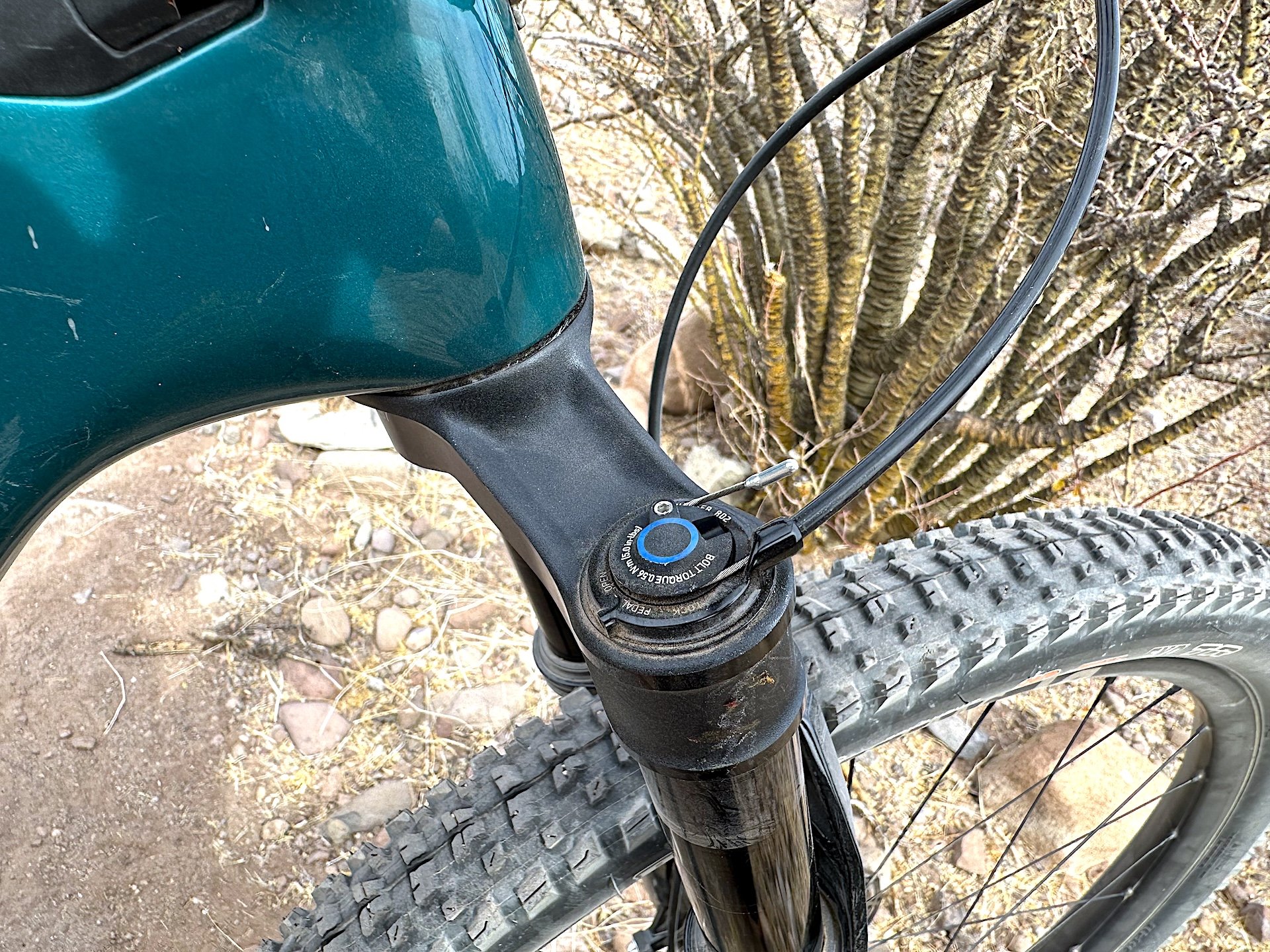
Lock the rear, lock the front...
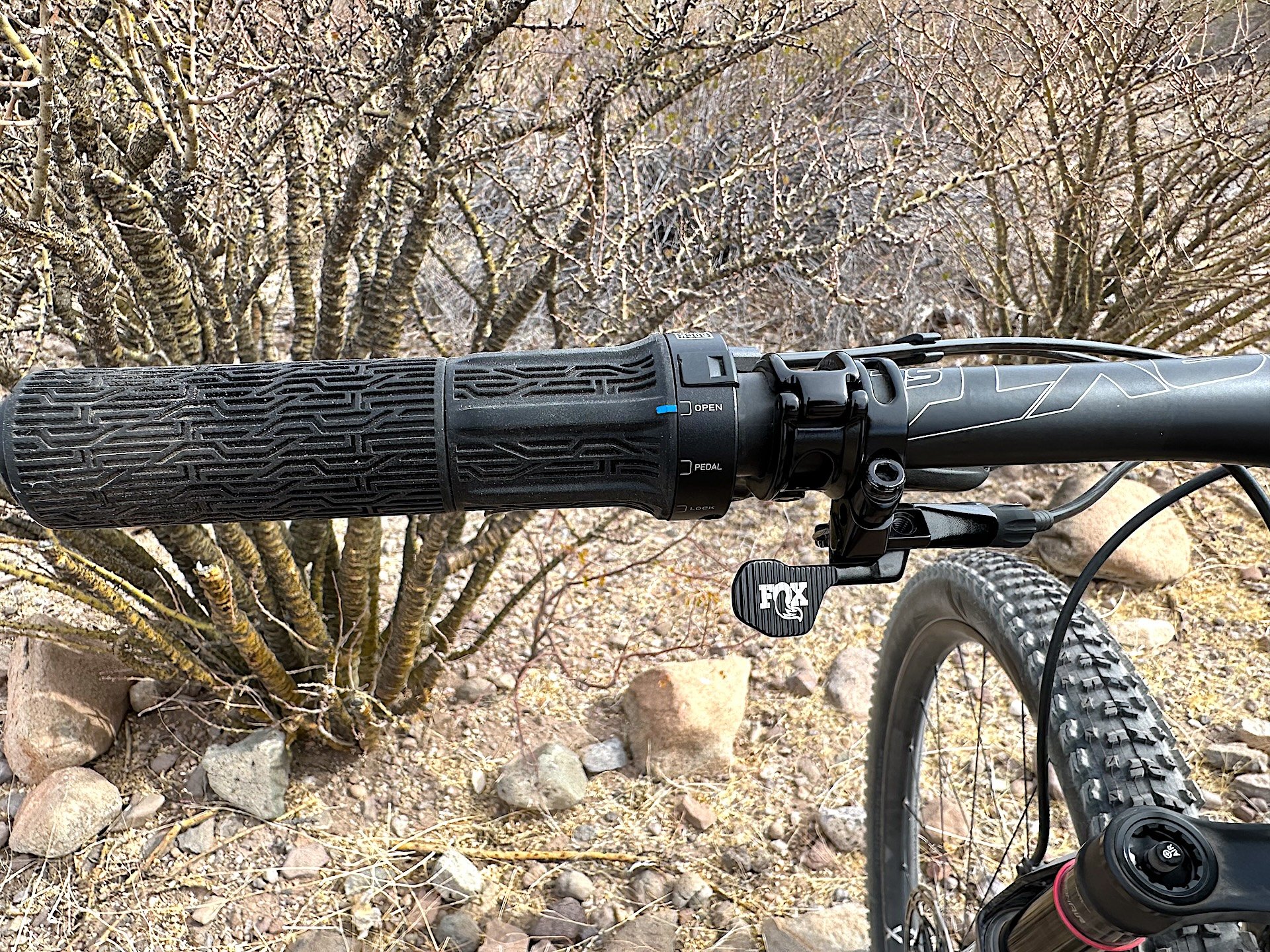
All with the 3-way twist of a grip. Normally, I loathe lockouts, as well as extra cables. I also loathe push-on grips. Here, though, it all sorta makes sense in a sadistic kind of way...
The rear triangle is asymmetrical from brake to drive side, with the brake side featuring a curious outward bow above and around the rear brake caliper. This, evidently, was done to facilitate the right amount of flex in the brake side seat stay without interfering with brake performance. Suspension is designed around 30% sag, with a 40mm stroke rear shock and a leverage ratio that starts at around 3:1 and falls slightly from there, in order to combat the ultra-rampy nature of small volume air canisters. The overall progressivity of the suspension is about 10% per Yeti. This seems like more sag and less progressivity than what might be considered traditional XC oriented designs, and in fact the sag point, travel amount and rate of progression are VERY similar to that found on the existing SB120. So, all this preamble aside about XC focused design, it should ride about the same as the SB120, right?
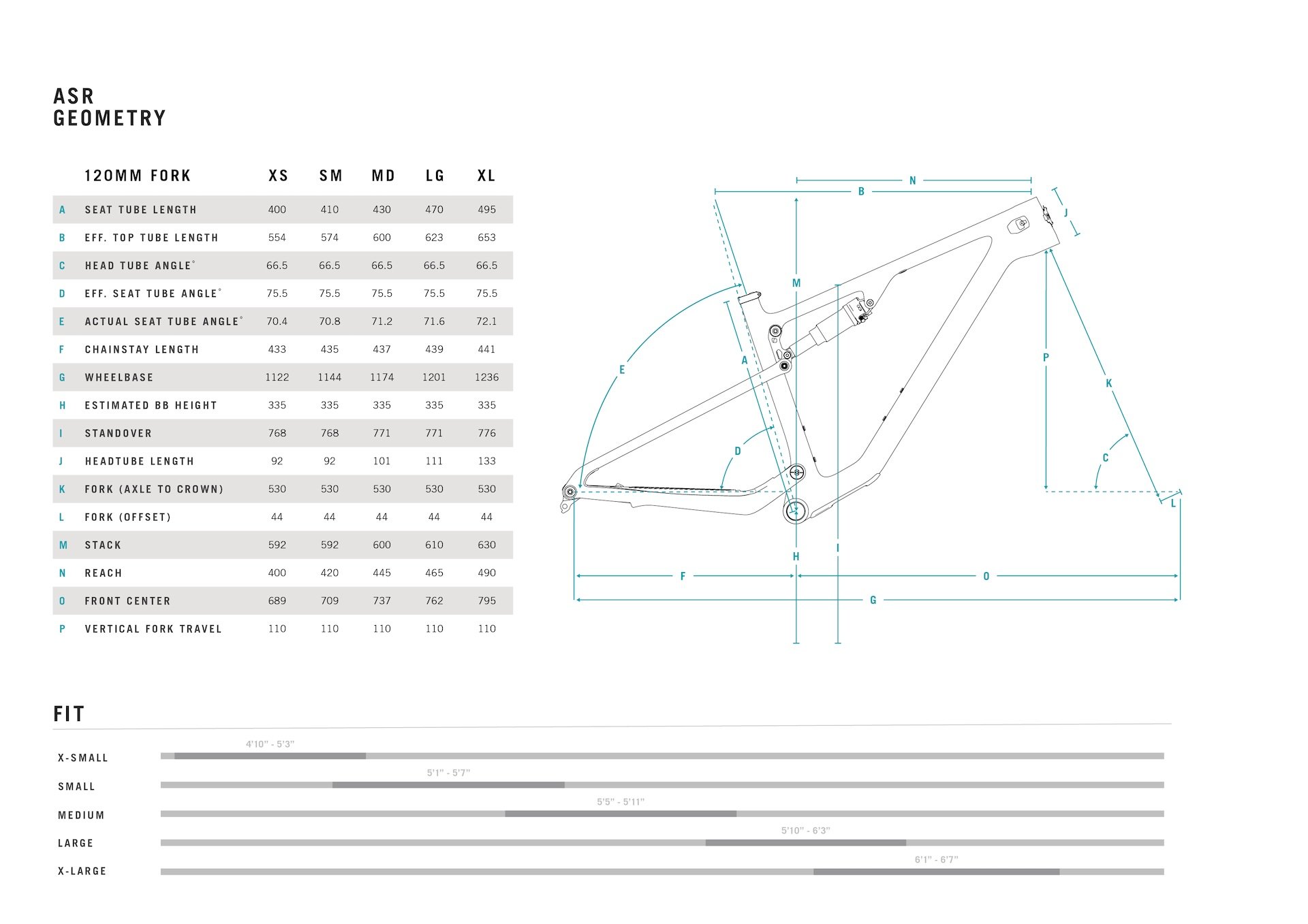
I mean, on paper it sure does read a lot like the SB120...
RIDE
I have spent 30 hours aboard the $8,600 US T3 X0 Transmission version of the ASR in the past month (with the $2,000 US upgrade fancy not-yet-released in the wild DT Swiss XRC1200 wheels) and have an SB120 here for back to back comparisons. And with regard to that “they look real similar on paper” notion, yeah, no. Dead wrong. It is hard to believe that the SB120 and the ASR share the same parents. The ARS is blazing fast, nervy, an effort rewarding racehorse. It is amphetamine. The SB120, by comparison, is almost somnambulant. Composed, stable, comfortable, implacable, and efficient, but in comparison to the ASR it rides like someone poured quaaludes into the coffee.
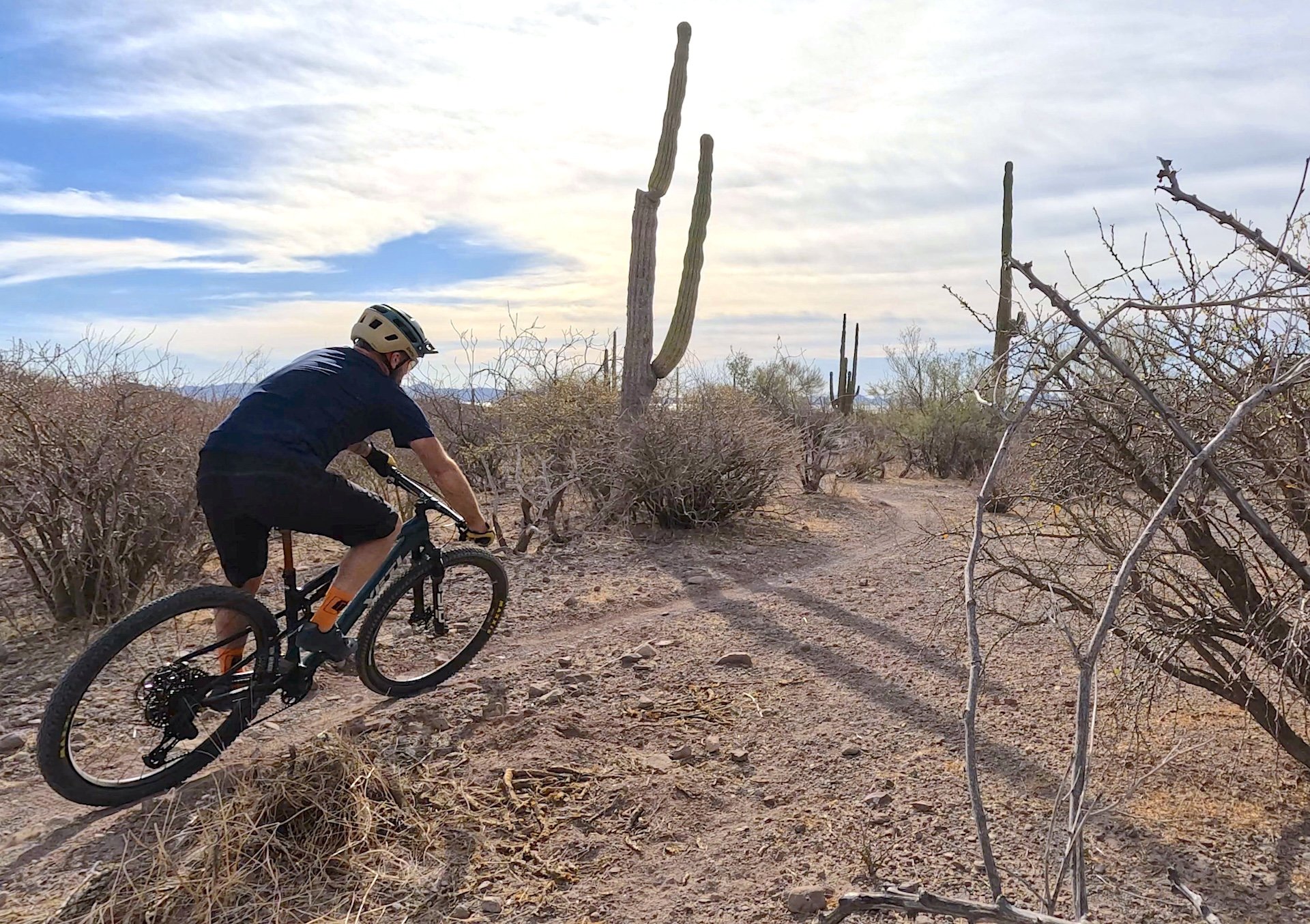
"Yeah, mellow ride. Gentle pace. I promise. Traaaaan keeeeee lowwww..." Pfffft.
Let me clarify something here. I absolutely love the SB120. It is one of the most capable bikes in this travel segment that I have ever ridden. It feels like it has more travel than it does, it possesses an impeccable stability and balance, it pedals incredibly well, without sacrificing traction or energy, and it just floats over all kinds of shit with a gentlemanly grace that is really loveable. It is an exemplary trail bike. The SB120 is the bike I want for the long days in the back of nowhere. And the ASR makes it feel like a boat anchor.
If the SB120 feels like it has an inch or two more travel than it really does, the ASR lets you know that 115mm is all there is on tap, bub, and don’t you forget it. The pedals tug here and there under power, especially on ledgy climbs, but dear lord does it get after it when you stomp on them. It is lively. Very lively. The suspension may not be as velvety or sophisticated as the Switch Infinity on the SB120, but the ASR telegraphs exactly what is happening on the ground, and responds instantaneously to changes in effort or body weight shifts. This “feel” that it transmits, along with the generous sag and my choosing to run the rebound damping kind of light, in turn makes for some incredible tractability. You have to pay attention to your effort, but it is so damn easy to read what is going on from your legs to the cranks, the rear wheel and the ground that the bike feels almost telepathic in how it reacts. It picks up speed everywhere, and putting the hammer down on undulating terrain where it is possible to milk an extra nudge of energy from every crown or hump in the trail is downright addictive. The first few rides on this bike forced me to recalibrate my riding, because I was pinning my heart rate everywhere I went. It is easy to ride fast, and it wants to go fast, and it made a sick little endorphin addict out of me in about ten minutes flat. The somewhat modest (by long travel measures) seat angle is a pedaling delight, and is perfectly aligned for grinding out the climbs and biting down on the stem (the incredibly light Bike Yoke stem, the first stem I have seen in God knows how long with actual pinch bolts, instead of a detachable face plate. Every Gram Counts, remember).
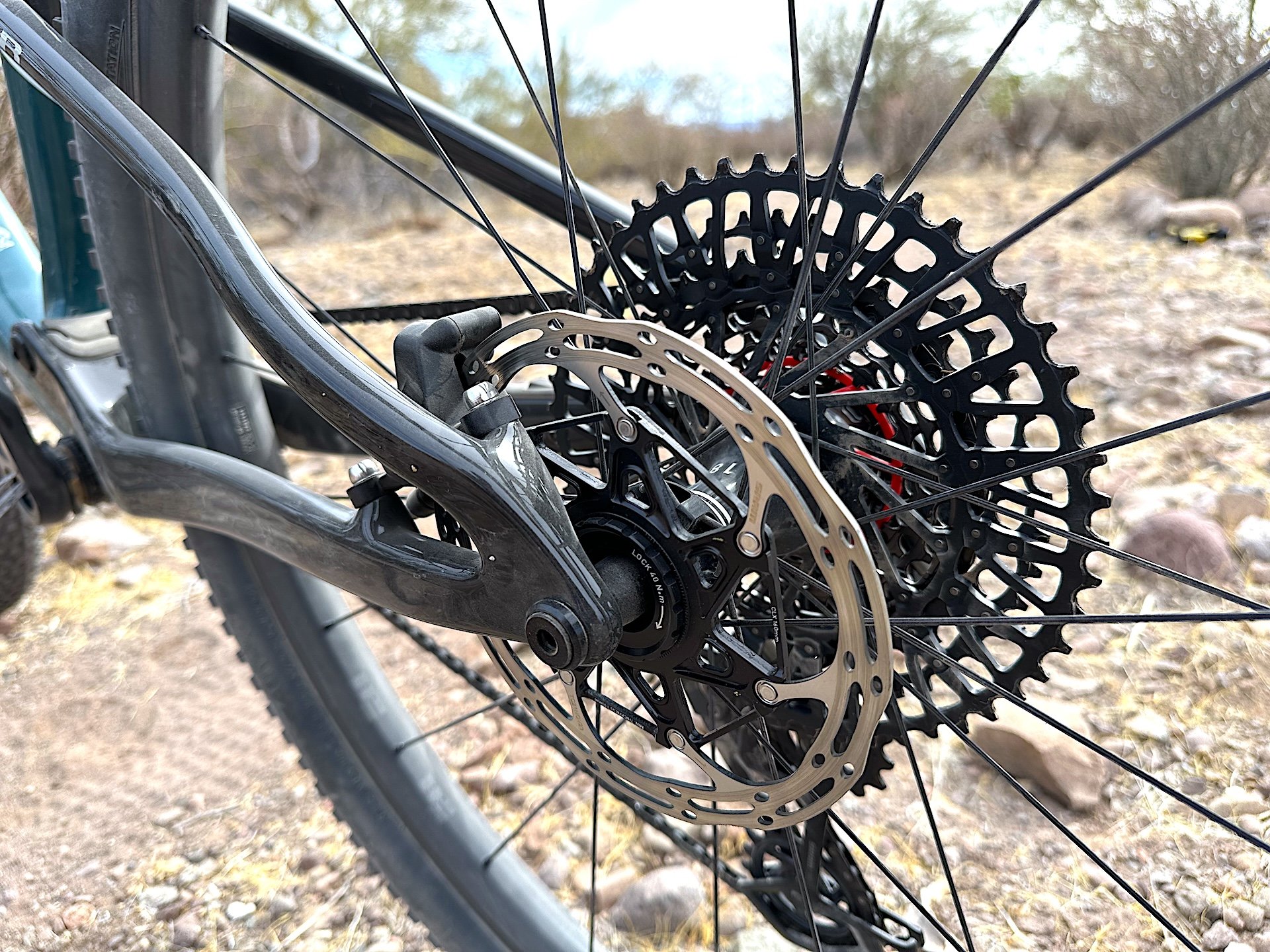
A little asymmetry, and a little rear rotor...
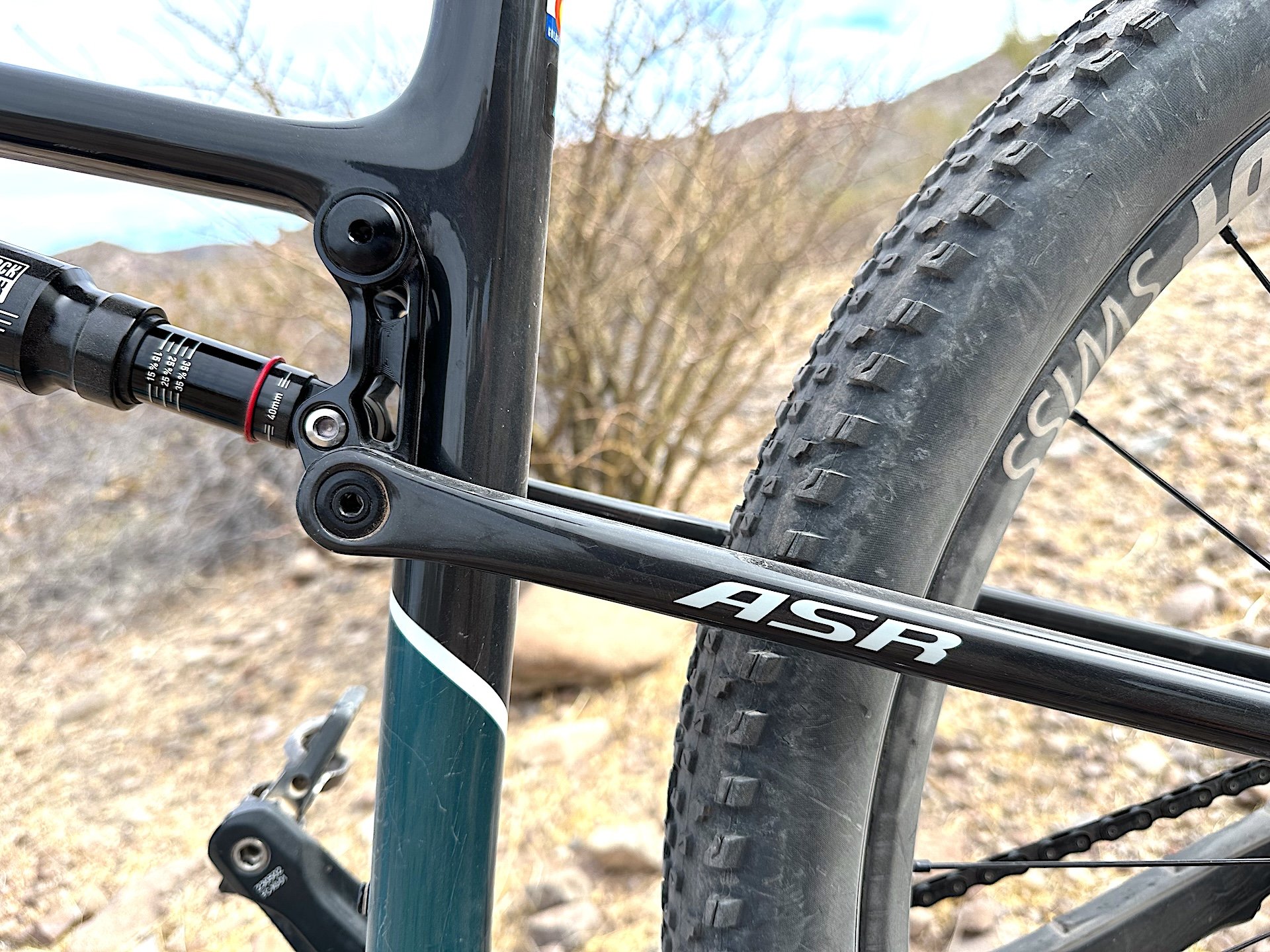
Hogged out 7075 upper link, and a new twist on an old name.

An uncompromising compromise - Yeti could have spec'd a one piece bar/stem to save some more weight, but instead this svelte BikeYoke stem and Race Face bar keeps the options open.
This is what race bikes should feel like. Yeti designed it for this, and they got that part right. In a nod to the gnarlification of XC racing at the World Cup level, the ASR geometry is doing what is happening over in trail bike land, and fronts are getting longer along with head angles slackening. This does add an element of stability, and racers who are laying down obscene watts while hammering through their own shimmering pain mirages will appreciate the added calm that the longer wheelbase brings. I have not ridden the new Specialized Epic yet, but I spent a couple years aboard the old Epic EVO, and it is still one of my favorite pain cave bikes. The ASR feels very much like a more evolved, more tractable, quicker version of that. This is a bike absolutely in step with the current zeitgeist of XC racing.
Just don’t go pretending it’s a trail bike. It will let you know where the edges are in short order. The handling may be more forgiving than the lawn darts of XC bikes past, but between the springy frame, the light damping, the featherweight and only euphemistically knobby Rekon Race rear tire, the minimalist DT Swiss XRC1200 wheelset, the Transfer SL dropper post that only lets you choose highposting or down all the way, the itty bitty brake rotors, and the intentional lively twang that the whole bike literally vibrates with, things can get uncomfortable in a hurry once you venture out of the stated parameters. If you want to race, Yeti has a new whip that is every bit the thoroughbred. But don’t try to pretend it’s something other than a race bike. Don’t lament that it doesn’t have in-frame storage, don’t try to overfork it, don’t get excited about the ample clearance for 2.4” tires and start fantasizing about wedging some Assegais in there. Just don’t. Revel in the freakish speed and the zero-effort, lightning fast responsiveness. The ASR is exactly what it needs to be.
If you even think the word “downcountry” when looking at it, go wash your mouth out with soap. Then go get yourself a nice SB120.
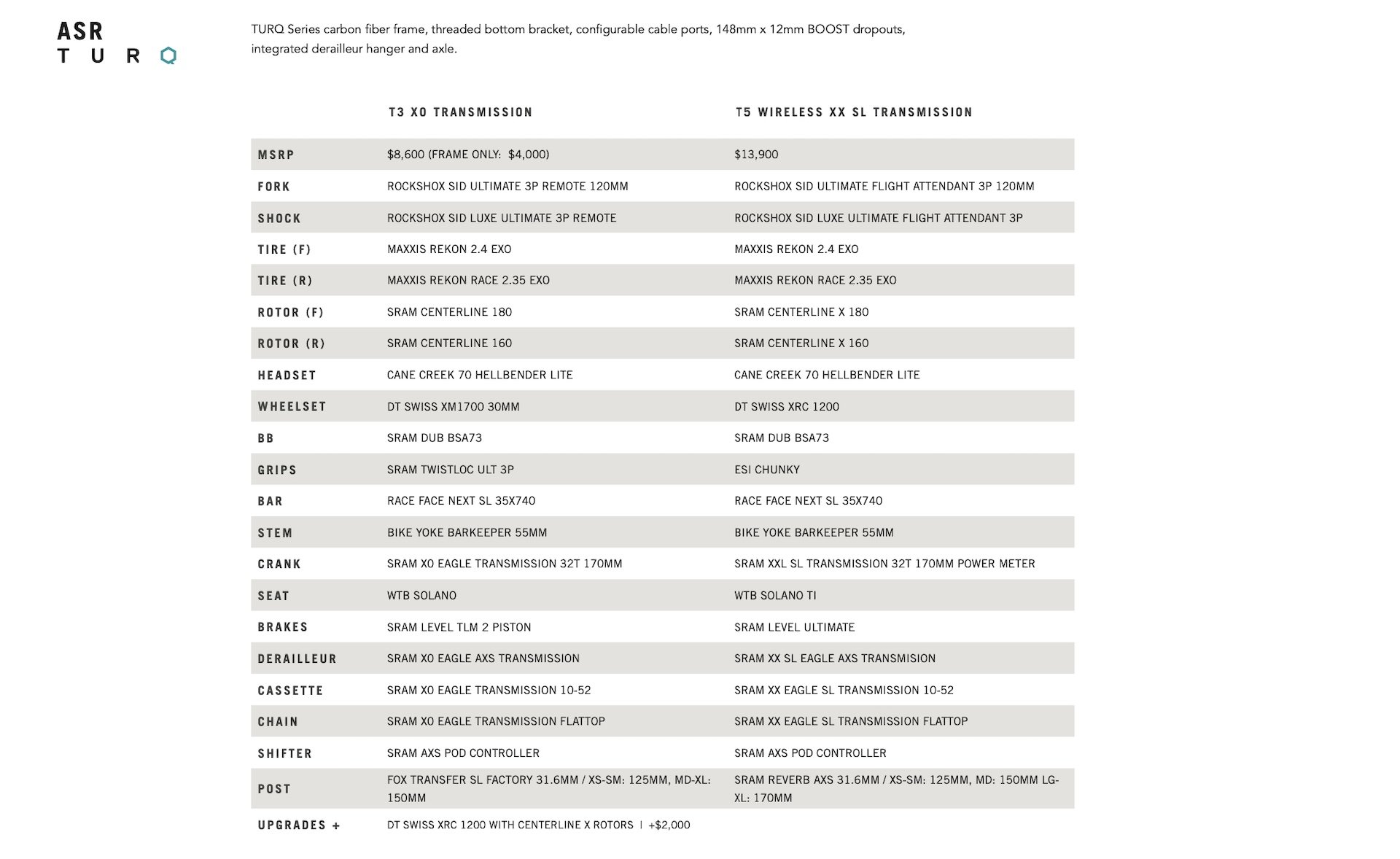
Look, don't shoot me. I'm only the messenger. Here's the expensive end of the price game for the ASR...
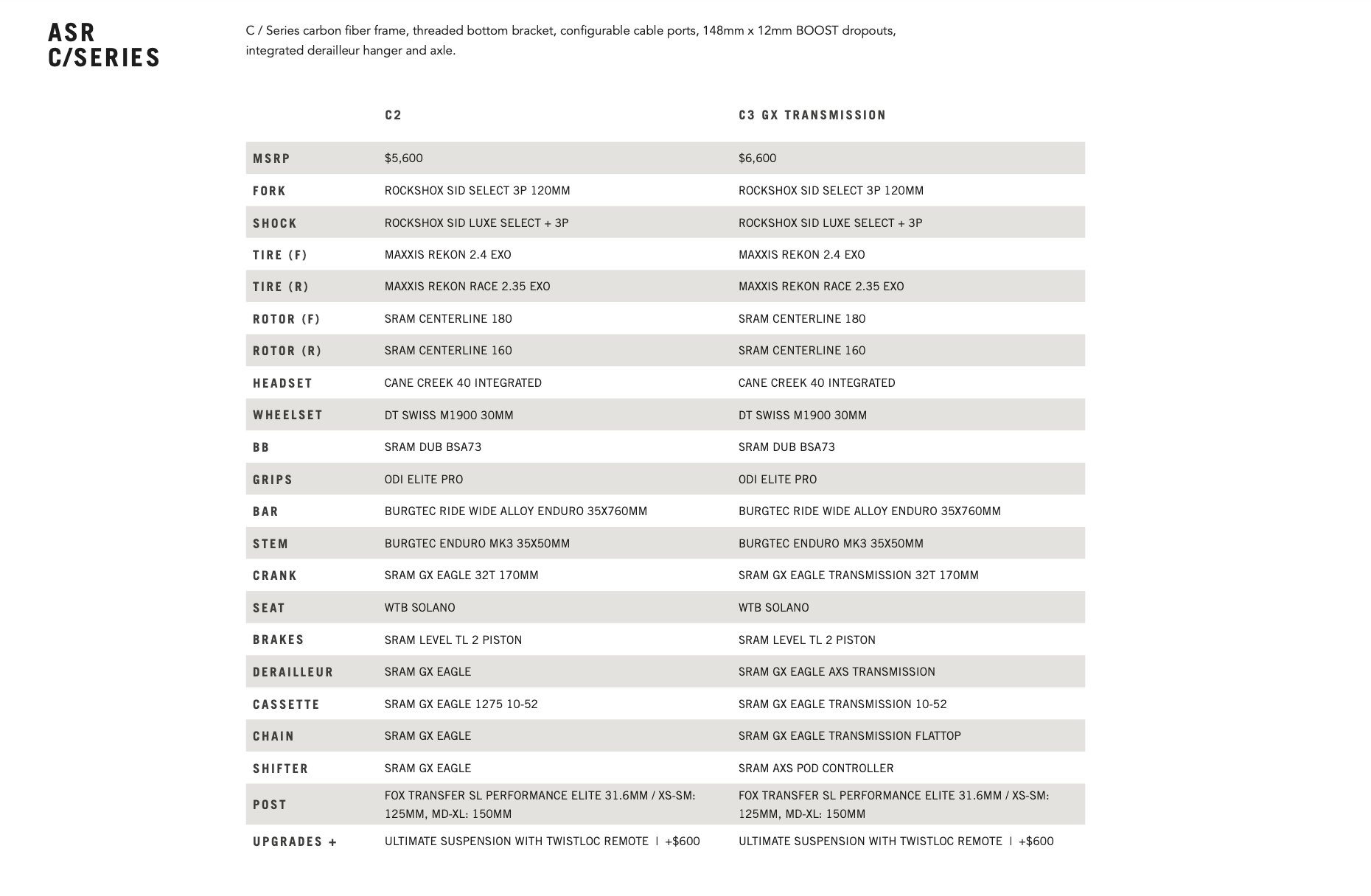
And here's the less executive class pricing.
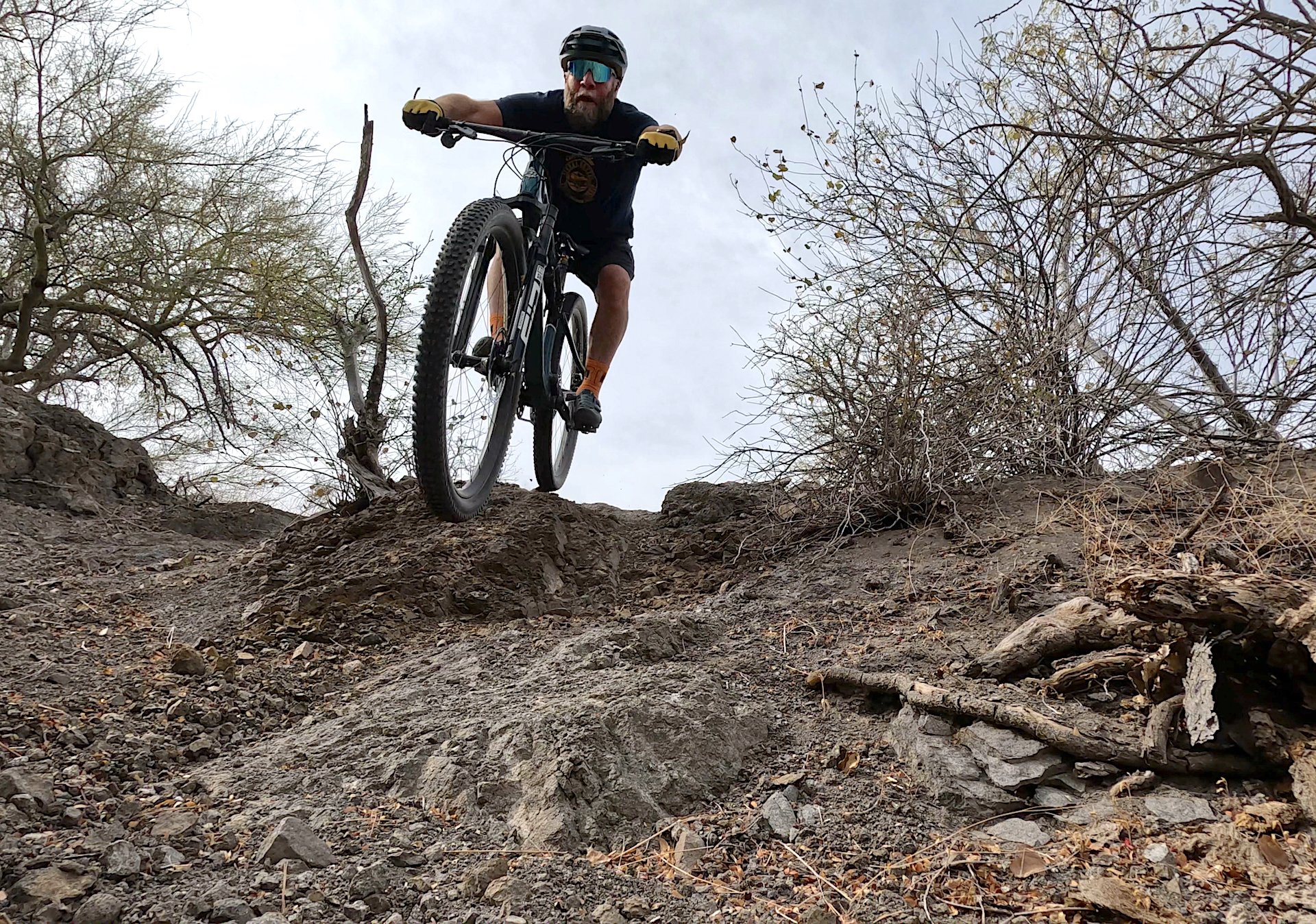
And here's me a few split seconds away from finding out just how badly things can go wrong in the desert with too much camera courage and not enough tire...
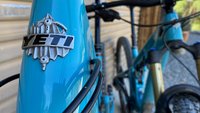










Comments
Lu Kz
1 month, 1 week ago
I suspect I speak for a lot of readers when I say I don't have a ton of interest in full suspension pure XC race level bikes, but man, I respect the hell out of them when a company is willing to do a platform justice. Once every couple years I get out for a romp on a machine like this at a demo day or some other event and it's always fun, but I am far from picking one up myself, especially in full suspension (it's a LOT of cheddar to get a full suspension one of the caliber you want), and even more now that I have a drop bar rigid monstercross build in the works.
The Kashima post on the Sid-Race-Ultimate level rockshox suspenson is too much, pure bling for the sake of bling.
If FRO is For Racing Only, what is ARS? Available (for) Racing Sometimes?
Edit: I can see that I messed up ARS and ASR. In my defense, I'm not the only one (Mike). I'm not going to change my acronym guess.
Reply
Mike Ferrentino
1 month, 1 week ago
Agreed to almost all of that. I love riding XC bikes. That feeling of speed and instantaneous reward for effort is an amazing rush. But unless I start pinning numbers onto skinsuits and shaving my legs again, I am generally willing to trade that edginess for comfort and broader capability. That does not in any way stop me from admiring the breed, though.
That Kashima isn't so much a bling statement. It is a weight statement. One of the compromises within the uncompromising. Aesthetically and functionally, I would have preferred something with infinite adjustability. But that would have weighed more. Something without a cable would have weighed even more still. Similarly, I would have preferred not to have remote lockout cables uglying up the joint, but going the Flight Attendant route would have cost buckets more cash AND weighed more. And going without lockouts would be an affront to the leg shaving ethos.
Reply
Lu Kz
1 month, 1 week ago
I understand the weight argument but the identically weighted Performance Elite model is right there. I guess they figured if someone is spending this amount of coin they expect gold and not poverty spec performance elite stuff.
Reply
Mike Ferrentino
1 month, 1 week ago
Ah, gotcha. I hadn't even realized the SL was available in Performance Elite. "Let them eat cake", she said...
Reply
Ryan
1 month, 1 week ago
ASR = Absurd Spending Required
Anywho....I'm so glad that XC bikes are evolving to be more capable, reliable, and most imporantly...fun.
Reply
Alex
1 month, 1 week ago
ASR = Active Suspension Racing. Gotta go to the way-back machine to find that.
Reply
Spencer Nelson
1 month, 1 week ago
Lu, I read the article as soon as it came out, there definitely were a half dozen "ARS's" in there. I was waiting for a poop joke, butt I guess they wouldn't add anything to the... bottom line.
Reply
Mike Ferrentino
1 month, 1 week ago
Oof. So, I wrote this, sent it to Pete for edits, then checked in as soon as it went live and noticed all the ARS spellings in the second half of the copy, dove back in and started cleaning before (hopefully, but apparently not) anyone caught the gaffe. I spent most of my time cursing Pete, figuring he had edited those into place. Then I went and read my Word doc that I had pulled copy from, and for some reason halfway through, I had switched ASR to ARS. This is as good a time as any, I guess, to cop to something I have been dealing with since I was a kid. Hi, I'm Mike. I'm dyslexic. Nice to teem you.
Reply
Friday
1 month, 1 week ago
All XC bikes look like Evos now. Can't fault them, the design works.
The Transmission cassette look criminal on this bike though, shuold be XX1 11 speed only.
Reply
Deniz Merdano
1 month, 1 week ago
I was thinking about this yesterday. I wish we had a way to lock out a gear in AXS app and run 11sp cassettes. It seems comically easy to do so! I would even utilize it on my 12sp cassette. for training purposes or mechanical limiting for when you break a chain and missing links to go on the big gear. again, seems like a no brainer, which I am for sure gonna hear from Sram guys that I indeed am a no brainer..
Reply
Mark
1 month, 1 week ago
So when is Cooper getting one and sending it down 5th Horseman as an addendum to this write-up?
Reply
Todd Hellinga
1 month, 1 week ago
the good thing about being a hardtail aficionado is that bikes like this do seem like trail bikes! hahaha
I just picked up a (barely) used Blur with a 120mm pike, oh man it's a rocket and it really does just want to go go go. Really looking forward to it and have a feeling I'll actually ride it a lot more than I think.
Reply
2wls4ever
1 month, 1 week ago
Great to see more modern geometry xc bikes offered to the market. They are still my backyard favorite (Downieville) grab and go ride.
Reply
Cee Cee
1 month, 1 week ago
Nice hoops. There's lots of rubber between Rekon R and Assegai. Dissect or be dissected
P.s. if your bike feels telepathic, you might have a mental health problem
Reply
Fat_Tony_NJ
1 month, 1 week ago
On another review of this bike, I suggested that Rekon rear, Forekaster front could make this a bike a (gulp) Down Country beast.
Reply
Mike Ferrentino
1 month, 1 week ago
And it begins! the insidious neutering of a perfectly good bike that starts out with good intentions and eventually renders the bike a sad shadow of its former self. First the tires. Then bigger rotors. Then long stroking the shock, overforking. Wider bars, at some point contemplation of cutting storage holes into downtubes...
@Ceecee, your bikes don't talk to you? Hmmm.
Reply
Lu Kz
1 month, 1 week ago
Have you considered how this bike would ride with a single offset bushing in the linkage?
Reply
Fat_Tony_NJ
1 month, 1 week ago
SlackSet could help! ;)
Reply
PowellRiviera
1 month, 1 week ago
Love the writing and history lesson. Thanks Mike
Reply
Please log in to leave a comment.